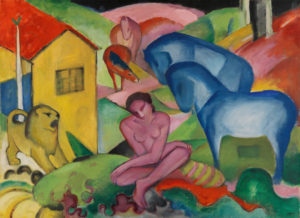
Paris’ Musee de l’Orangerie revisits two major German painters Franz Marc and August Macke— who were part of the “Blue Rider” group (Der Blaue Reiter)— with the exhibition “L’adventure du cavalier bleu” (to June 17, 2019). The exhibition focuses on Marc and Macke’s artistic relationship, how their lives and work intersected and evolved.
The Blue Rider group, a pioneering movement of German Expressionism —including Vasily Kandinsky, Franz Marc, August Macke, Gabriele Münter and several others—formed in 1911 in Munich. In a manifesto for ‘Der Blaue Reiter’ (1912) Marc wrote “Art today is moving in directions of which our forebears had no inkling; the Horsemen of the Apocalypse are heard galloping through the air; artistic excitement can be felt all over Europe.”
The name ‘Der Blaue Reiter’ refers to a key motif in Kandinsky’s work: the horse and rider. Along with exhibitions the group published an influential almanac by the same name—included in the exhibition— featuring contemporary, primitive and folk art. It dissolved with the onset of World War I. Both Marc and Macke were killed in combat.
The two artists were harbingers of abstraction. After WWI when the National Socialists took power their work was labeled as degenerate (1936-1937) and removed from German museums. With their careers cut short these two artist are less known than many others of that era. In recent years, however, Marc and Macke are becoming better known outside Germany. In October 1999, Franz Marc’s painting Der Wasserfall (The Waterfall) was sold by Sotheby’s in London for $5.06 million. This price set a record for Franz Marc’s work and for twentieth-century German painting.
“L’adventure du cavalier bleu,” to June 17, 2019, Musee de l’Orangerie, Paris

